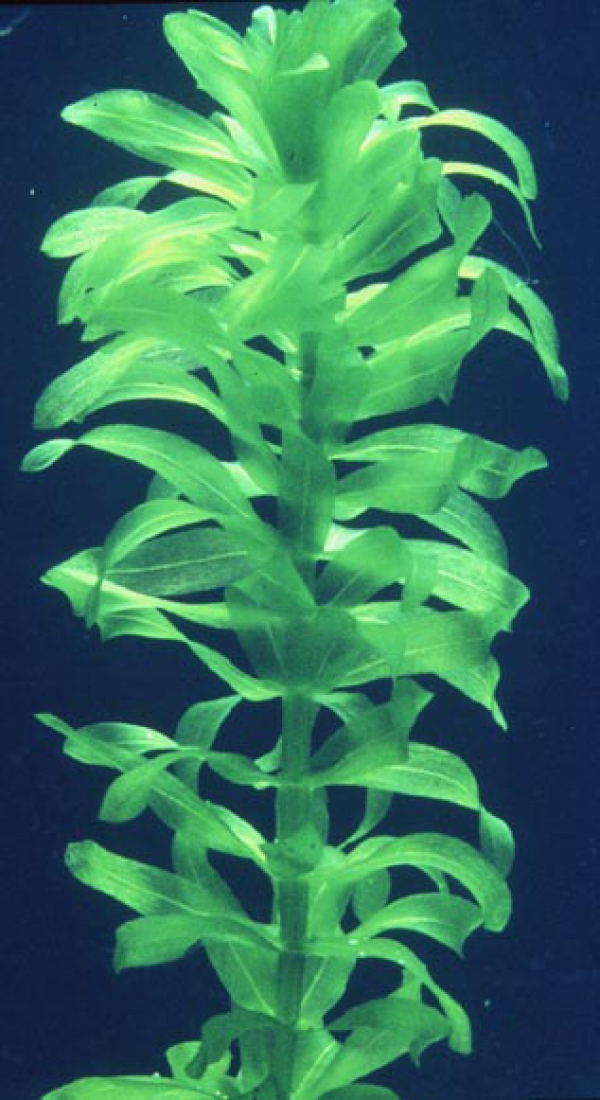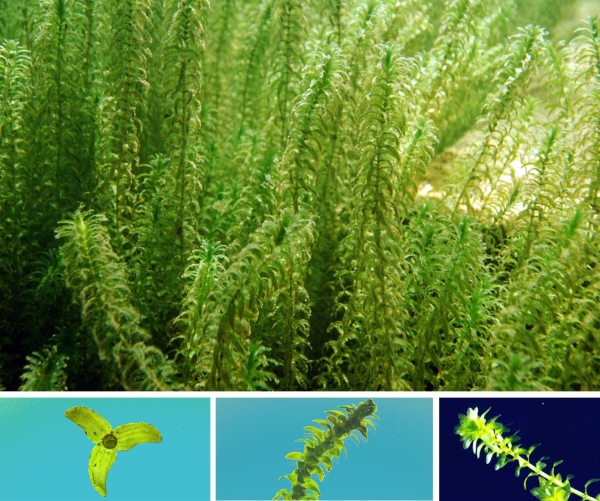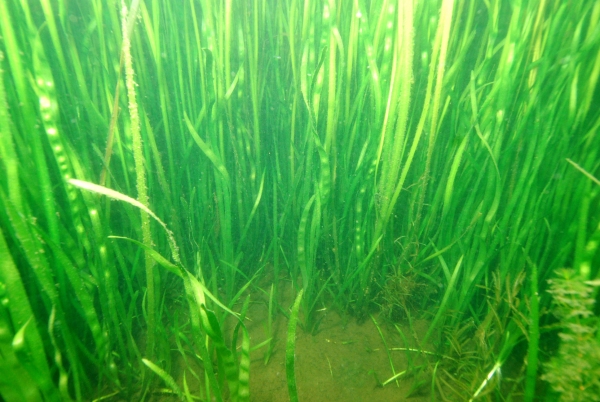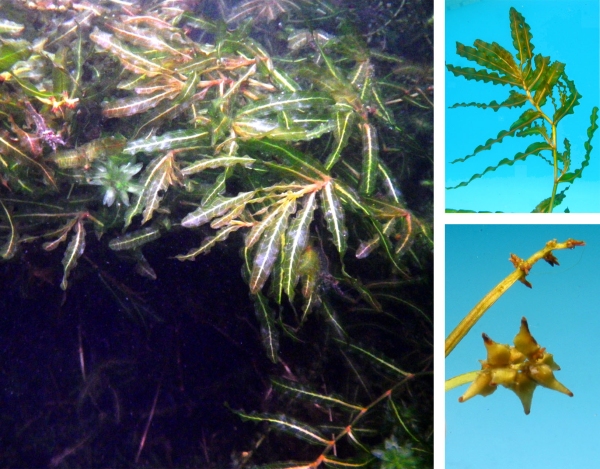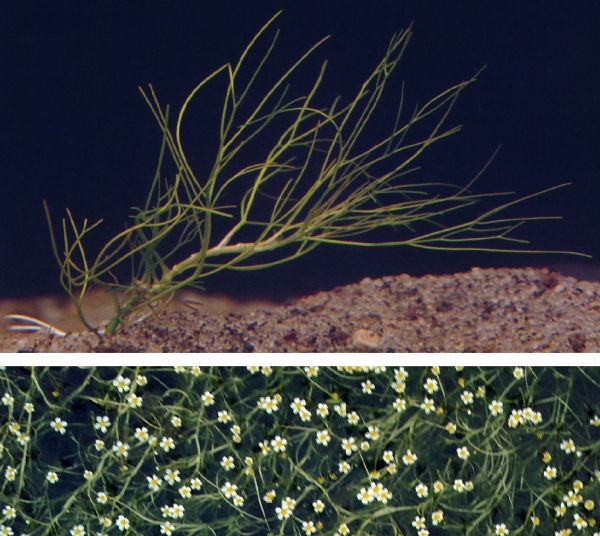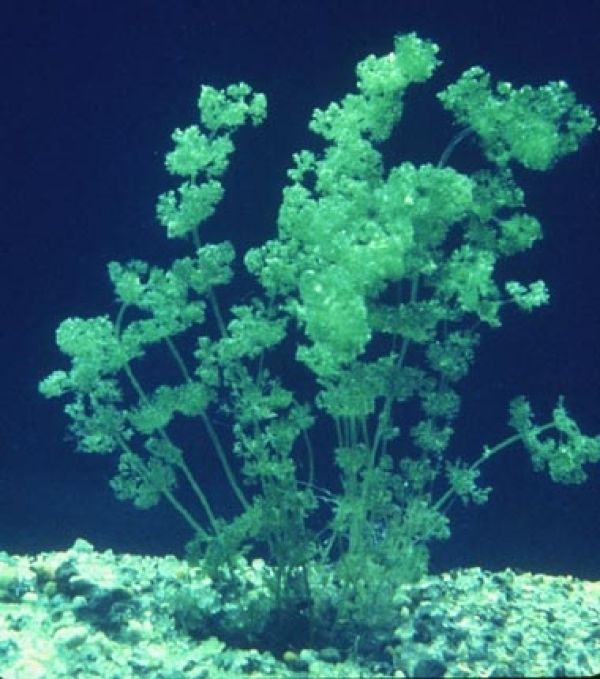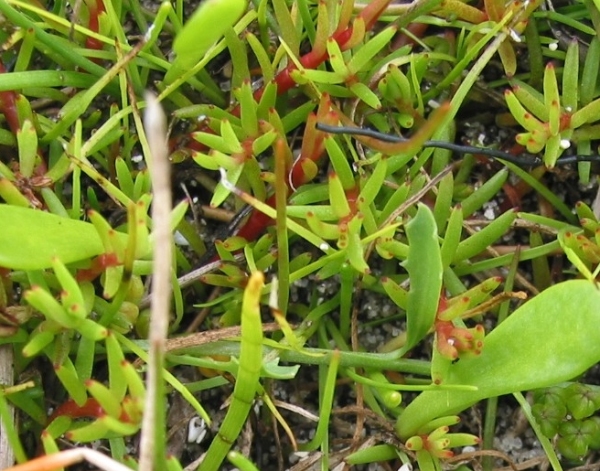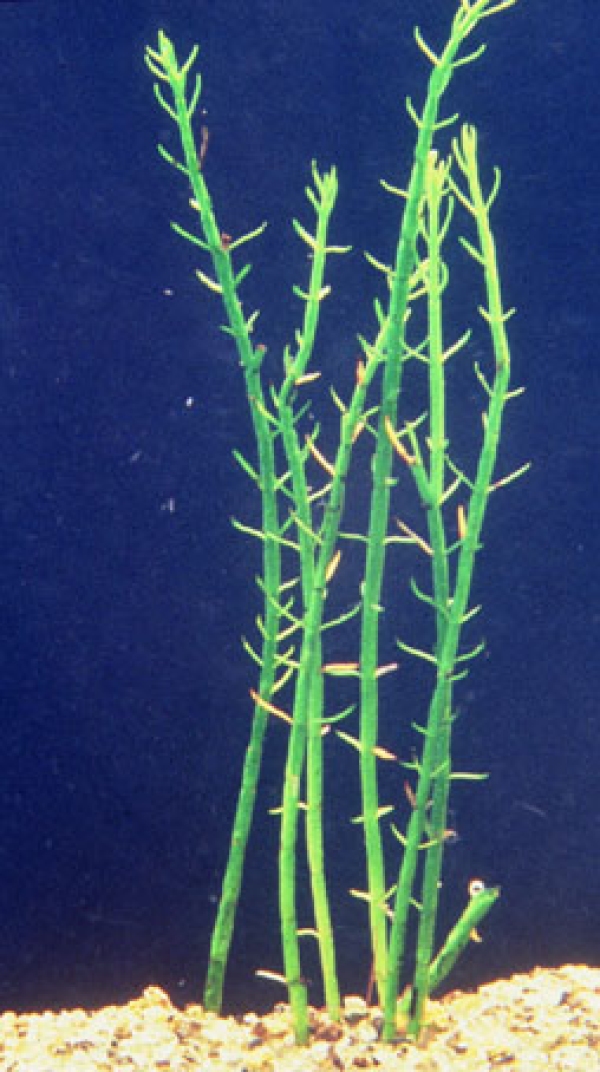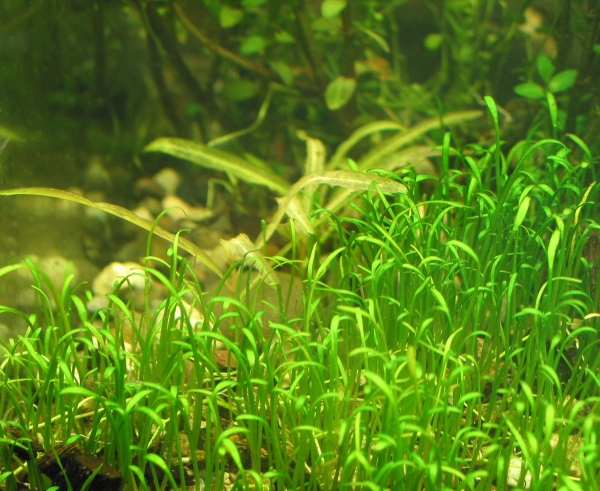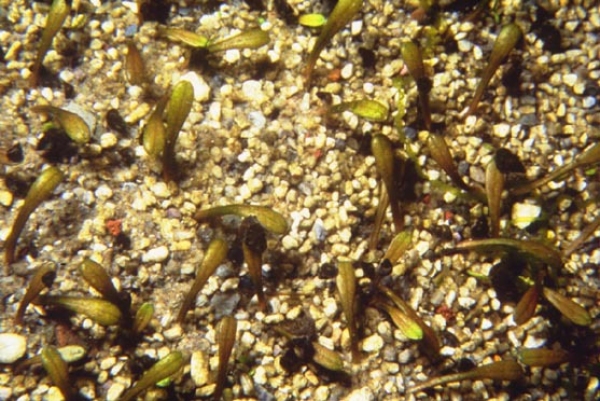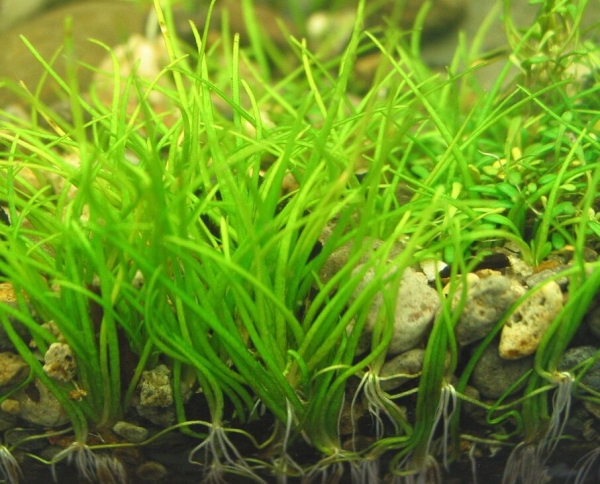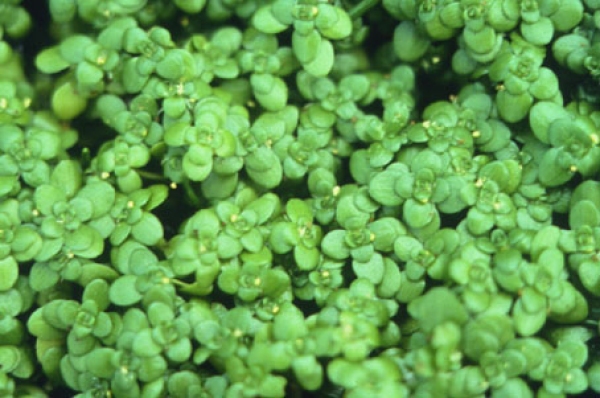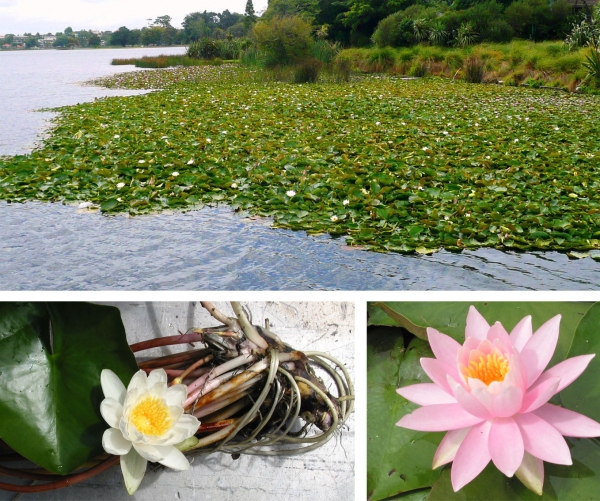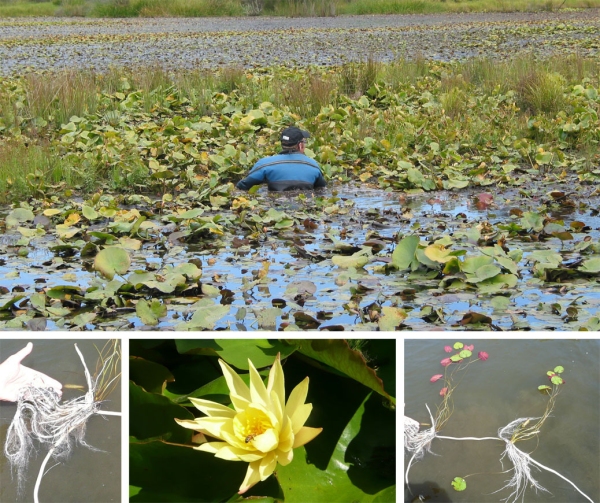Click on tabs to view different types of submerged macrophytes
Submerged macrophytes
Tall growing species
Family: Ceratophyllaceae
Ceratophyllum demersum L. (commonly called Hornwort)
Ceratophyllum is an introduced submerged perennial that normally grows with the base of its stem buried in sandy or silty substrates, but it does not form roots. Prone to dislodgement, its buoyant stems may become free-floating. It can form a dense subsurface canopy and reach a height of 5–6 m, and frequently grows as a mono-specific community.
Propagation is by fragmentation of its brittle stems. Flowers do occur on this monoecious species, but there is no evidence of seed production in New Zealand.
Ceratophyllum occurs from Northland to Wairarapa and is still actively spreading. It is particularly common in the Waikato River and Rotorua lakes.
Family: Haloragaceae
Myriophyllum propinquum A. Cunn. Myriophyllum triphyllum Orchard
Both M. propinquum and M. triphyllum are native submerged perennial macrophytes that occur throughout New Zealand. Plants grow to 3 m tall in deep water (up to 3.5 m water depth), and occur in both standing and flowing water. Short-term de-watering is survived by both species and in these situations M. propinquum reduces to a prostrate or erect herb up to 10 cm high.
They are monoecious species with flowers in the axils of emergent leaves. From November to March stands may be conspicuous when apical flower heads, which are often reddish in colour, emerge above the water level. M. propinquum usually has unisexual flowers with male flowers at upper and female flowers at lower whorls of the stem. Flowers of M. triphyllum are usually hermaphrodite. These milfoils propagate both sexually by seed and vegetatively from fragments and rhizomes.
Family: Hydrocharitaceae
Hydrilla verticillata (Lf) Royle
Hydrilla is an introduced submerged, much-branched perennial plant, which forms dense often mono-specific communities that can grow to the water surface from depths of 4m forming dense canopies. It grows from the water's margins to ca. 6.5 m.
It spreads by rhizomes, stolons and stem fragments. Hydrilla also forms underground tubers, and turions in the axils of its leaves. No seeds are produced in New Zealand because the plant is dioecious and only male plants are present.
Hydrilla occurs only in the Hawkes Bay region of the North Island, having been recorded in Lakes Tutira, Waikapiro, Opouahi and Elands Lake.
Egeria densa Planch
Egeria is an introduced submerged bottom-rooted perennial that thrives in turbid, enriched and slow-flowing waters, and roots in either silty–organic or sandy–gravel substrate. It can form dense mono-specific growth up to 5 m tall, reaching the water surface.
Like Hydrilla, Egeria does not produce seed in New Zealand, with only male flowering plants being present here. The characteristic white flowers may be seen in the summer months protruding just above the water surface. Egeria propagates from stem fragments containing lateral buds that give rise to new plants.
Egeria is abundant in the Waikato district, and scattered throughout the North Island, with an increasing distribution. It is well established in Marlborough in the South Island, and has recently been found in the Avon River in Christchurch.
Lagarosiphon major (Ridley) Moss ex Wager
Lagarosiphon is an introduced submerged perennial that grows from the shallow water margins to water depths of 6.5 m and typically forms dense mono-specific stands. This tall-growing plant can reach the surface from depths of ca. 4 m and roots in sandy or silty substrates.
New plants develop from stem fragments that are readily transported between waterbodies on boats and boat trailers. Lateral spread within a lake also occurs by stem fall, and plants soon overgrow most other vegetation in clear waters. There is no sexual reproduction by Lagarosiphon in New Zealand, with only the female plants of this dioecious species being present here.
Lagarosiphon has been recorded throughout much of New Zealand. Its distribution is still increasing.
Elodea canadensis Michx
Elodea is an introduced submerged freshwater perennial that forms dense mono-specific stands up to 5 m tall and may also be present as a low-growing member of a mixed community in shallower waters. In very clear water the depth limit of Elodea may extend to 10 m. The canopy of this species is typically less dense than that of the other Hydrocharitaceae species mentioned here. But like the other Hydrocharitaceae species in New Zealand, Elodea spreads by vegetative fragmentation from stem material.
Elodea occurs throughout the country and is the most widely distributed of the tall-growing submerged adventive species.
Vallisneria gigantea (Graeb.) (commonly called eelgrass)
V. gigantea is an introduced attached stoloniferous perennial which can grow to a height of 5 m. It forms dense stands of vegetation and can colonise lake sediments to a depth of 9 m. Currently its distribution is restricted to several sites in the North Island, with Lake Pupuke the most well known site.
The leaves are strap like and arise from a stout rhizome. Leaves vary in length from a few centimetres to 5 m in deeper water and are 0.4-8 cm in width. The leaf tips, when intact are obtuse to acute, with fine serrulate margins towards the apex. There is no evidence of viable seed production in New Zealand material although mixed populations of this dioecious species do occur.
Family: Potamogetonaceae
Potamogeton crispus L. (commonly called curly leaved pondweed) Potamogeton ochreatus Raoul
Potamogeton crispus is an adventive pondweed which, unlike the native pondweeds, can be problematic in flowing water and, although a typically freshwater species, it will tolerate brackish water. Plants can grow to 4 m in deep water, with stunted rosette forms of the plant occurring in very shallow water (<0.3 m).
Seed is set and seedlings are commonly found at field sites. It also reproduces vegetatively from rhizomes and stem fragments, as well as winter buds and turions.
In shallow water it may also set seed and behave more like an annual, whilst deeper water plants persist as perennials.
P. crispus is common throughout the North Island and in Marlborough and Canterbury in the South Island. It is still spreading.
Potamogeton ochreatus is a native rhizomatous submerged herb that grows rooted in stony to silty substrate to a depth of 10 m in clear water but is common at much shallower depths in turbid waters.
It propagates from seed, and also reproduces vegetatively from rhizomes and stem fragments. It is widespread throughout New Zealand.
Family: Ranunculaceae
Ranunculus trichophyllus Chaix (commonly called water buttercup)
R. trichopllyus is an introduced submerged perennial with either erect or creeping stems, that are often rooted at the nodes. The plant may grown up to 3 m tall in standing water, or form long trailing stems of similar length in flowing water.
The leaves are usually 3–6 cm long and are highly divided, ending in thread-like segments. The flowers are white with a yellow centre about 15 mm in diameter (usually less) and held above the water surface.
This species is widespread throughout New Zealand, except the Northland lakes, and spreads by seed and stem fragments.
Family: Ruppiaceae
Family: Ceratophyllaceae
Ceratophyllum demersum L. (commonly called Hornwort)
Ceratophyllum is an introduced submerged perennial that normally grows with the base of its stem buried in sandy or silty substrates, but it does not form roots. Prone to dislodgement, its buoyant stems may become free-floating. It can form a dense subsurface canopy and reach a height of 5–6 m, and frequently grows as a mono-specific community.
Propagation is by fragmentation of its brittle stems. Flowers do occur on this monoecious species, but there is no evidence of seed production in New Zealand.
Ceratophyllum occurs from Northland to Wairarapa and is still actively spreading. It is particularly common in the Waikato River and Rotorua lakes.
Family: Haloragaceae
Myriophyllum propinquum A. Cunn. Myriophyllum triphyllum Orchard
Both M. propinquum and M. triphyllum are native submerged perennial macrophytes that occur throughout New Zealand. Plants grow to 3 m tall in deep water (up to 3.5 m water depth), and occur in both standing and flowing water. Short-term de-watering is survived by both species and in these situations M. propinquum reduces to a prostrate or erect herb up to 10 cm high.
They are monoecious species with flowers in the axils of emergent leaves. From November to March stands may be conspicuous when apical flower heads, which are often reddish in colour, emerge above the water level. M. propinquum usually has unisexual flowers with male flowers at upper and female flowers at lower whorls of the stem. Flowers of M. triphyllum are usually hermaphrodite. These milfoils propagate both sexually by seed and vegetatively from fragments and rhizomes.
Family: Hydrocharitaceae
Hydrilla verticillata (Lf) Royle
Hydrilla is an introduced submerged, much-branched perennial plant, which forms dense often mono-specific communities that can grow to the water surface from depths of 4m forming dense canopies. It grows from the water's margins to ca. 6.5 m.
It spreads by rhizomes, stolons and stem fragments. Hydrilla also forms underground tubers, and turions in the axils of its leaves. No seeds are produced in New Zealand because the plant is dioecious and only male plants are present.
Hydrilla occurs only in the Hawkes Bay region of the North Island, having been recorded in Lakes Tutira, Waikapiro, Opouahi and Elands Lake.
Egeria densa Planch
Egeria is an introduced submerged bottom-rooted perennial that thrives in turbid, enriched and slow-flowing waters, and roots in either silty–organic or sandy–gravel substrate. It can form dense mono-specific growth up to 5 m tall, reaching the water surface.
Like Hydrilla, Egeria does not produce seed in New Zealand, with only male flowering plants being present here. The characteristic white flowers may be seen in the summer months protruding just above the water surface. Egeria propagates from stem fragments containing lateral buds that give rise to new plants.
Egeria is abundant in the Waikato district, and scattered throughout the North Island, with an increasing distribution. It is well established in Marlborough in the South Island, and has recently been found in the Avon River in Christchurch.
Lagarosiphon major (Ridley) Moss ex Wager
Lagarosiphon is an introduced submerged perennial that grows from the shallow water margins to water depths of 6.5 m and typically forms dense mono-specific stands. This tall-growing plant can reach the surface from depths of ca. 4 m and roots in sandy or silty substrates.
New plants develop from stem fragments that are readily transported between waterbodies on boats and boat trailers. Lateral spread within a lake also occurs by stem fall, and plants soon overgrow most other vegetation in clear waters. There is no sexual reproduction by Lagarosiphon in New Zealand, with only the female plants of this dioecious species being present here.
Lagarosiphon has been recorded throughout much of New Zealand. Its distribution is still increasing.
Elodea canadensis Michx
Elodea is an introduced submerged freshwater perennial that forms dense mono-specific stands up to 5 m tall and may also be present as a low-growing member of a mixed community in shallower waters. In very clear water the depth limit of Elodea may extend to 10 m. The canopy of this species is typically less dense than that of the other Hydrocharitaceae species mentioned here. But like the other Hydrocharitaceae species in New Zealand, Elodea spreads by vegetative fragmentation from stem material.
Elodea occurs throughout the country and is the most widely distributed of the tall-growing submerged adventive species.
Vallisneria gigantea (Graeb.) (commonly called eelgrass)
V. gigantea is an introduced attached stoloniferous perennial which can grow to a height of 5 m. It forms dense stands of vegetation and can colonise lake sediments to a depth of 9 m. Currently its distribution is restricted to several sites in the North Island, with Lake Pupuke the most well known site.
The leaves are strap like and arise from a stout rhizome. Leaves vary in length from a few centimetres to 5 m in deeper water and are 0.4-8 cm in width. The leaf tips, when intact are obtuse to acute, with fine serrulate margins towards the apex. There is no evidence of viable seed production in New Zealand material although mixed populations of this dioecious species do occur.
Family: Potamogetonaceae
Potamogeton crispus L. (commonly called curly leaved pondweed) Potamogeton ochreatus Raoul
Potamogeton crispus is an adventive pondweed which, unlike the native pondweeds, can be problematic in flowing water and, although a typically freshwater species, it will tolerate brackish water. Plants can grow to 4 m in deep water, with stunted rosette forms of the plant occurring in very shallow water (<0.3 m).
Seed is set and seedlings are commonly found at field sites. It also reproduces vegetatively from rhizomes and stem fragments, as well as winter buds and turions.
In shallow water it may also set seed and behave more like an annual, whilst deeper water plants persist as perennials.
P. crispus is common throughout the North Island and in Marlborough and Canterbury in the South Island. It is still spreading.
Potamogeton ochreatus is a native rhizomatous submerged herb that grows rooted in stony to silty substrate to a depth of 10 m in clear water but is common at much shallower depths in turbid waters.
It propagates from seed, and also reproduces vegetatively from rhizomes and stem fragments. It is widespread throughout New Zealand.
Family: Ranunculaceae
Ranunculus trichophyllus Chaix (commonly called water buttercup)
R. trichopllyus is an introduced submerged perennial with either erect or creeping stems, that are often rooted at the nodes. The plant may grown up to 3 m tall in standing water, or form long trailing stems of similar length in flowing water.
The leaves are usually 3–6 cm long and are highly divided, ending in thread-like segments. The flowers are white with a yellow centre about 15 mm in diameter (usually less) and held above the water surface.
This species is widespread throughout New Zealand, except the Northland lakes, and spreads by seed and stem fragments.
Family: Ruppiaceae
Ruppia megacarpa R. Mason Ruppia polycarpa R. Mason (commonly called horses' mane weed)
These native species grow in relatively shallow water (ca. 2 m) and have slender creeping rhizomes (highly branched in the R. polycarpa) and thread-like long narrow leaves. R. megacarpa is a coastal species growing in brackish water or saline ponds and lagoons, whilst R. polycarpa has a wider habitat growing in estuarine water as well as freshwater lakes and streams.
They are readily recognised by their distinctive flowers and distinguished from each other by the number of fruit within a flower. Both species have small flowers that are terminal on white stalks reaching 30 to 150 cm towards the water surface. Following pollination at the water surface the flower stalk retracts in a characteristic coil with the maturing fruit (achenes). In the flowers of R. megacarpa there are typically four fruits and in R. polycarpa flowers there are at least six. The fruits of R. polycarpa are generally 2 mm long brown and smooth, those of R. megacarpa are 4.5 mm long and olive-green in colour.
Low growing species
Family: Characeae
Chara corallina Willd Chara globularis Thuill
Charophytes are commonly found growing on the bottom of relatively clear lakes, streams and coastal lagoons, forming extensive meadows over 2 m tall in deep water or shorter tufts 2–3cm tall in shallow waters. Both C. corallina and C. globularis are native and propagate vegetatively or by oospores. Chara is often a first coloniser of new or seasonal waterbodies, via oospores introduced on visiting birds.
Chara is widespread throughout New Zealand.
Nitella hookeri A.Br. Nitella hyalina (DC) Ag.
Nitella forms "meadows", often in association with Chara species, of low growing plants in waterbodies. Best developed meadows are up to 2 m tall in deep, clear water lakes where they can extend to 40 m deep, and play an important role in sediment stabilisation. Similar in appearance to Chara, but all species of Nitella have forked or repeatedly branching branchlets.
They propagate from sexual fruiting bodies or by vegetative fragments. Plants are readily broken at nodes along their axils and these fragments form new rhizoids and shoots.
All Nitella species found in New Zealand are native. They are widespread throughout New Zealand from coastal waters to mountain tarns. N. hookeri is the most commonly collected charophyte from streams, drains and lakes, whereas N. hyalina is less conspicuous and tends to occur only in the shallow water of lakes.
Family: Elatinaceae
Elatine gratioloides Cunn.
E. gratioloides is a small native light-green leafy herb that forms low growing swards of matted stems in shallow water around the margins of lakes and rivers.
The stems are rooted at nodes and are usually 1–2 cm long if emergent or may be as long as 20 cm when submerged. The leaves are opposite and small (2–16 mm long and 5 mm wide) and have very short leaf stalks (petioles). The flowers are inconspicuous, are found in the leaf axils and occur alternately up the stem. Flowers maybe found all year round. Plants spread from both seed and by vegetative growth.
Family: Haloragaceae
Myriophyllum pedunculatum Hook. f. subsp. novae-zelandiae Orchard.
M. peduculatum is a low growing native species that has short erect creeping stems which form semi-aquatic swards or turf on damp ground or shallow waters.
The plants are usually less then 10 cm tall, with small (5–10 mm long) inconspicuous leaves that are opposite and entire. The flowers are unisexual, small, pink or red in colour, and located in the axils of the upper leaves. The fruit is globular and reddish in colour. New colonies of M. pedunculatum establish from seed and spread by vegetative growth. It occurs through New Zealand.
Family: Isoetaceae
Isoetes kirkii A. Braun
This perennial native species is found in shallow water (0 to 6 m) in ponds, lakes and streams throughout New Zealand, though it is more common in oligotrophic waters where it can form dense, closed swards ca 15 cm (occasionally 30 cm) high.
The plants bear leaves in a crowded tuft, which are fleshy, cylindrical, stiff and arch outward. The leaves are dark green in colour, but white in the lower buried portion, and usually 10–30 cm long and 2–4 mm in diameter containing visible turgid air chambers. Sporangia are enclosed in sheathing leaf bases, the sexes separate on the same plant.
Family: Ranunculaceae
Ranunculus limosella F. Muell. ex Kirk
This is a small, slender plant producing leaves singly or in tufts along a creeping buried stem. The leaves occur one or more at nodes along the stem. They are linear or spathulate and 1–2 cm long on exposed plants and may be longer on plants that are permanently submerged. The flowers are ca 6 mm in diameter, pink-brownish in colour and occur on stalks of 1–2 cm in height on emerged plants.
R. limosella is the only native species of Ranunculus with entire leaves.
It is found throughout New Zealand from coastal to inland lakes and waterways, though it appears to be vulnerable to habitat modification and eutrophication.
Family: Scrophulariaceae
Glossostigma diandrum (L.) O Kuntze, formerly G. submersum Petrie. Glossostigma elatinoides Benth
These native species are slender, creeping, perennial herbs that grow in shallow water or damp margins around waterways. Both are widespread in New Zealand.
Their leaves are entire, opposite or in fascicles, and the leaf stalks are about the same length as the leaf blade. The flowers are solitary, axillary and inconspicuous. Plants reproduce both sexually by seed, and asexually by creeping stems and stem fragments.
G. diandrum and G. elatinoides are distinguished by their leaf shape and flowers. G. diandrum has a linear-spathulate leaf compared with narrow-obvate leaves in G. elatinoides. On G. diandrum the flowers are ca 15 mm in diameter with two stamens, and on G. elatinoides they are larger 2.5–3.5 mm in diameter with four stamens.
Family: Apiaceae
Family: Characeae
Chara corallina Willd Chara globularis Thuill
Charophytes are commonly found growing on the bottom of relatively clear lakes, streams and coastal lagoons, forming extensive meadows over 2 m tall in deep water or shorter tufts 2–3cm tall in shallow waters. Both C. corallina and C. globularis are native and propagate vegetatively or by oospores. Chara is often a first coloniser of new or seasonal waterbodies, via oospores introduced on visiting birds.
Chara is widespread throughout New Zealand.
Nitella hookeri A.Br. Nitella hyalina (DC) Ag.
Nitella forms "meadows", often in association with Chara species, of low growing plants in waterbodies. Best developed meadows are up to 2 m tall in deep, clear water lakes where they can extend to 40 m deep, and play an important role in sediment stabilisation. Similar in appearance to Chara, but all species of Nitella have forked or repeatedly branching branchlets.
They propagate from sexual fruiting bodies or by vegetative fragments. Plants are readily broken at nodes along their axils and these fragments form new rhizoids and shoots.
All Nitella species found in New Zealand are native. They are widespread throughout New Zealand from coastal waters to mountain tarns. N. hookeri is the most commonly collected charophyte from streams, drains and lakes, whereas N. hyalina is less conspicuous and tends to occur only in the shallow water of lakes.
Family: Elatinaceae
Elatine gratioloides Cunn.
E. gratioloides is a small native light-green leafy herb that forms low growing swards of matted stems in shallow water around the margins of lakes and rivers.
The stems are rooted at nodes and are usually 1–2 cm long if emergent or may be as long as 20 cm when submerged. The leaves are opposite and small (2–16 mm long and 5 mm wide) and have very short leaf stalks (petioles). The flowers are inconspicuous, are found in the leaf axils and occur alternately up the stem. Flowers maybe found all year round. Plants spread from both seed and by vegetative growth.
Family: Haloragaceae
Myriophyllum pedunculatum Hook. f. subsp. novae-zelandiae Orchard.
M. peduculatum is a low growing native species that has short erect creeping stems which form semi-aquatic swards or turf on damp ground or shallow waters.
The plants are usually less then 10 cm tall, with small (5–10 mm long) inconspicuous leaves that are opposite and entire. The flowers are unisexual, small, pink or red in colour, and located in the axils of the upper leaves. The fruit is globular and reddish in colour. New colonies of M. pedunculatum establish from seed and spread by vegetative growth. It occurs through New Zealand.
Family: Isoetaceae
Isoetes kirkii A. Braun
This perennial native species is found in shallow water (0 to 6 m) in ponds, lakes and streams throughout New Zealand, though it is more common in oligotrophic waters where it can form dense, closed swards ca 15 cm (occasionally 30 cm) high.
The plants bear leaves in a crowded tuft, which are fleshy, cylindrical, stiff and arch outward. The leaves are dark green in colour, but white in the lower buried portion, and usually 10–30 cm long and 2–4 mm in diameter containing visible turgid air chambers. Sporangia are enclosed in sheathing leaf bases, the sexes separate on the same plant.
Family: Ranunculaceae
Ranunculus limosella F. Muell. ex Kirk
This is a small, slender plant producing leaves singly or in tufts along a creeping buried stem. The leaves occur one or more at nodes along the stem. They are linear or spathulate and 1–2 cm long on exposed plants and may be longer on plants that are permanently submerged. The flowers are ca 6 mm in diameter, pink-brownish in colour and occur on stalks of 1–2 cm in height on emerged plants.
R. limosella is the only native species of Ranunculus with entire leaves.
It is found throughout New Zealand from coastal to inland lakes and waterways, though it appears to be vulnerable to habitat modification and eutrophication.
Family: Scrophulariaceae
Glossostigma diandrum (L.) O Kuntze, formerly G. submersum Petrie. Glossostigma elatinoides Benth
These native species are slender, creeping, perennial herbs that grow in shallow water or damp margins around waterways. Both are widespread in New Zealand.
Their leaves are entire, opposite or in fascicles, and the leaf stalks are about the same length as the leaf blade. The flowers are solitary, axillary and inconspicuous. Plants reproduce both sexually by seed, and asexually by creeping stems and stem fragments.
G. diandrum and G. elatinoides are distinguished by their leaf shape and flowers. G. diandrum has a linear-spathulate leaf compared with narrow-obvate leaves in G. elatinoides. On G. diandrum the flowers are ca 15 mm in diameter with two stamens, and on G. elatinoides they are larger 2.5–3.5 mm in diameter with four stamens.
Family: Apiaceae
L. ruthiana is a slender, turf-forming perennial that has creeping stems, and erect tapering cylindrical leaves give the appearance of a grassy sward. The plants grow in the shallow margins of lakes, ponds, swamps and streams, and can tolerate short periods of emergence. It is a native species and common throughout New Zealand.
The slender creeping rhizomes have two or more leaves at each node. The leaves are ca 10 cm long and only a few mm in diameter. Distinctive septa are clearly visible when viewed against the light. The flowers and fruit form only when the plants are emergent and are not readily observed. The flowers are produced on short stalks. The fruit are ovoid and distinctly ribbed. Plant spread is via seed production and vegetatively from creeping rhizomes.
Floating leaved species
Family: Callitrichaceae
Callitriche stagnalis Scop. (commonly called starwort)
Starwort forms soft bright green patches of vegetation, which are characterised by stems having apical rosettes of close-set floating leaves. It is a conspicuous feature in drains where it can impede waterflow. It is and introduced species and widespread throughout New Zealand.
C. stagnalis generally grows up to 1 m tall in water or prostrate and mat-like on damp ground. The slender stems have opposite, linear to narrow-lanceolate leaves (7–12 mm long) separated by elongated internodes. At the apex, the leaves are typically more crowded, 2–5 mm long, obovate and form floating rosettes.
Male and female flowers are solitary or together, and the fruit is 15 mm in diameter, round and narrowly winged. Plants also reproduce vegetatively by creeping stems.
Family: Hydrocharitaceae
Ottelia ovalifolia Rich (commonly called swamp lily).
O. ovalifolia is a heterophyllous plant with ribbon like submerged leaves on juvenile plants and ovate to oblong glossy surface floating leaves on mature plants. The mature leaves are up to 16 cm long and 3–6 cm wide and are attached to the base of the plant by long (ca 40 cm) petioles.
The flowers are bisexual 4–5 cm across, and held above the water level in a prominent terminal spathe. The petals are white with an orange base and orange stamens, delicate and creased in appearance.
This species is introduced and still spreading in both the North and South Island, but is most commonly found in Northland, in fertile farm dams, growing to a depth of ca 3 m in sandy or in rich organic sediments.
Family: Nymphaeaceae
Nymphaea alba L. (commonly known as the water lily)
This plant has either submerged creeping rhizomes, or short, erect, tuberous stems buried in the mud. Stems produce thick (up to 5 mm in diameter) white fleshy roots. The leaves are dark-green, glossy and long stalked, rounded to broad-ovate in outline and strongly cleft at the base. They first appear with blades rolled lengthwise from each side, and unroll on reaching the water surface to reach ca 5–60 cm in width. Flowers are solitary and floating, or stiffly emergent. They are regular in shape and typically large 10–20 cm across. The fruit are a berry-like capsule that ripens under water. Certain species of Nymphaea produce numerous seed that give rise to new plants, but many of the forms in New Zealand appear to be infertile culture hybrids. All species of Nymphae present in New Zealand are introduced.
Nymphaea is widespread throughout New Zealand but mostly found in ornamental ponds, renowned for their distinguished and variously coloured flowers during the summer months.
Family: Potamogetonaceae
Potamogeton cheesemanii A. Benn. (commonly called pondweed)
P. cheesemanii is a native species that is widespread and common throughout New Zealand. It occurs in both standing and flowing waters (where it can grow to ca 8 m depth) and it is tolerant of short periods of emergence. In deep or flowing water only the submerged leaf form may be present. These leaves are translucent, dull-green or brownish, narrow and long (usually 6–10 cm long and 0.5–1.5 cm wide) sometimes wavy and have 5–7 veins. The floating leaf is leathery, green or red-brown in colour, oval in shape and usually 3–4 cm long and 1.5–2.5 cm wide.
Seed dispersal is an important mode of propagation for this species. Flowers occur on dense spikes (2.5 cm long) that are held above the water surface at flowering, and curved below when fruiting. The fruit (achenes) are green-brown, flattened and three ridged.
Family: Callitrichaceae
Callitriche stagnalis Scop. (commonly called starwort)
Starwort forms soft bright green patches of vegetation, which are characterised by stems having apical rosettes of close-set floating leaves. It is a conspicuous feature in drains where it can impede waterflow. It is and introduced species and widespread throughout New Zealand.
C. stagnalis generally grows up to 1 m tall in water or prostrate and mat-like on damp ground. The slender stems have opposite, linear to narrow-lanceolate leaves (7–12 mm long) separated by elongated internodes. At the apex, the leaves are typically more crowded, 2–5 mm long, obovate and form floating rosettes.
Male and female flowers are solitary or together, and the fruit is 15 mm in diameter, round and narrowly winged. Plants also reproduce vegetatively by creeping stems.
Family: Hydrocharitaceae
Ottelia ovalifolia Rich (commonly called swamp lily).
O. ovalifolia is a heterophyllous plant with ribbon like submerged leaves on juvenile plants and ovate to oblong glossy surface floating leaves on mature plants. The mature leaves are up to 16 cm long and 3–6 cm wide and are attached to the base of the plant by long (ca 40 cm) petioles.
The flowers are bisexual 4–5 cm across, and held above the water level in a prominent terminal spathe. The petals are white with an orange base and orange stamens, delicate and creased in appearance.
This species is introduced and still spreading in both the North and South Island, but is most commonly found in Northland, in fertile farm dams, growing to a depth of ca 3 m in sandy or in rich organic sediments.
Family: Nymphaeaceae
Nymphaea alba L. (commonly known as the water lily)
This plant has either submerged creeping rhizomes, or short, erect, tuberous stems buried in the mud. Stems produce thick (up to 5 mm in diameter) white fleshy roots. The leaves are dark-green, glossy and long stalked, rounded to broad-ovate in outline and strongly cleft at the base. They first appear with blades rolled lengthwise from each side, and unroll on reaching the water surface to reach ca 5–60 cm in width. Flowers are solitary and floating, or stiffly emergent. They are regular in shape and typically large 10–20 cm across. The fruit are a berry-like capsule that ripens under water. Certain species of Nymphaea produce numerous seed that give rise to new plants, but many of the forms in New Zealand appear to be infertile culture hybrids. All species of Nymphae present in New Zealand are introduced.
Nymphaea is widespread throughout New Zealand but mostly found in ornamental ponds, renowned for their distinguished and variously coloured flowers during the summer months.
Family: Potamogetonaceae
Potamogeton cheesemanii A. Benn. (commonly called pondweed)
P. cheesemanii is a native species that is widespread and common throughout New Zealand. It occurs in both standing and flowing waters (where it can grow to ca 8 m depth) and it is tolerant of short periods of emergence. In deep or flowing water only the submerged leaf form may be present. These leaves are translucent, dull-green or brownish, narrow and long (usually 6–10 cm long and 0.5–1.5 cm wide) sometimes wavy and have 5–7 veins. The floating leaf is leathery, green or red-brown in colour, oval in shape and usually 3–4 cm long and 1.5–2.5 cm wide.
Seed dispersal is an important mode of propagation for this species. Flowers occur on dense spikes (2.5 cm long) that are held above the water surface at flowering, and curved below when fruiting. The fruit (achenes) are green-brown, flattened and three ridged.
For further information on these plants species see B.T. Coffey and J.S. Clayton. (1988). New Zealand Waterplants: A guide to plants found in New Zealand. Ruakura Agriculture Centre, Hamilton.

